Research
Ongoing research:
Dr. Sun specializes in regional climate dynamics and modeling. His current research focuses on developing dynamical and statistical downscaling techniques to project future climate change at the regional/local scale. He is currently working on the project of Climate Change Projections in California, with an emphasis on the Sierra Nevada Mountains. In this project, he designed the high-resolution regional climate modeling experiments using Weather Research and Forecasting Model (WRF), performed multi-decadal simulations and projected the end-of-21st-century hydroclimate (e.g., snowpack, precipitation) changes and weather extreme changes at 3-km resolution over the Sierra Nevada and 9-km resolution over California.
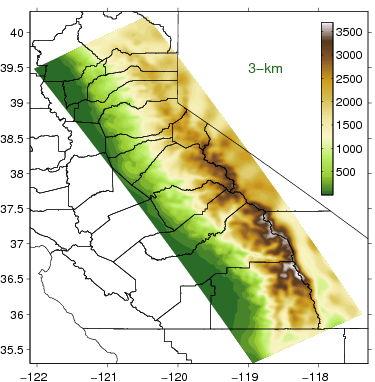 |
| Figure: WRF model resoloved high-resolution (3km by 3km) topography from the dynamically downscaled simulations in the California Sierra Nevada Mountains. |
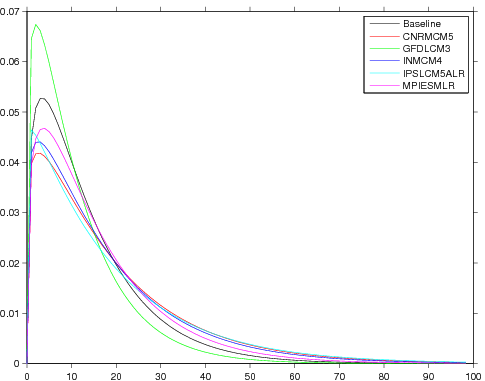 |
| Figure: The probability distributions of wet-day (>1 mm/day) January precipitation in the Sierra Nevada for the baseline (1991-2000) simulation forced by NARR reanalysis data and end-of-21st-century (2091-2100) simulations downscaled from five general circulation models (GCMs). |
Recent research:
His recent research included reconstructing historical climate and projecting climate change in the Greater Los Angeles Area with dynamical downscaling using regional WRF model and statistical downscaling model. Using this hybrid of dynamical and statistical techniques, he downscaled dozens of currently available global climate models to 2-km resolution and projected mid- and end-of-21st-century climate changes in temperature, precipitation, snowpack and surface runoff in the region under various greenhouse gas emissions scenarios.
He designed a number of WRF sensitivity experiments and investigated variablities of boundary layer cloudiness and thermal/moisture structures over the Southeast Pacific and tropical South America.
He also implemented multi-ensemble short-term sensitivity simulations to optimize WRF's simulations by tuning various subgrid-scale parameterization schemes (e.g., microphysics, planetary boundary layer, cumulus, radiation).
He collaborated with ecology scientists and investigated how the interactions between regional climate change and local ecosystems change the wild fire regime in southern California mountains and subsequent socio-economics impacts.
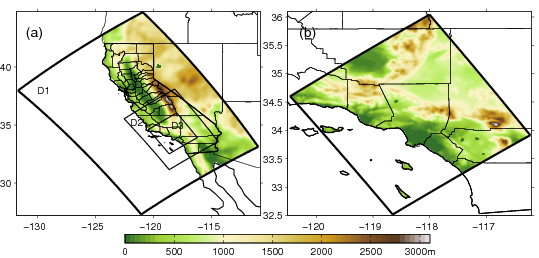 |
| Figure: (a) Model setup with three nested WRF domains (D1, D2, and D3) at resolutions of 18, 6, and 2 km; D1 Topography (m) is shown in color. (b) The innermost domain (D3) of the regional simulation, with 2-km resolution. |
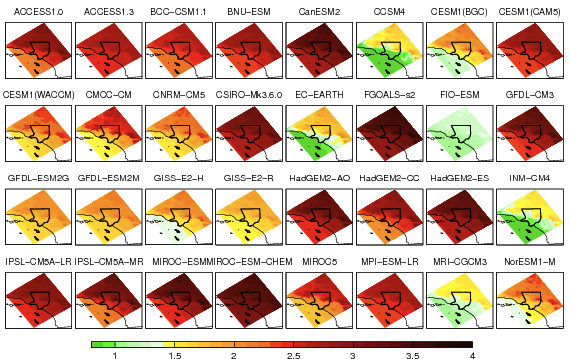 |
| Figure: Annual-mean warming patterns (°C) generated by applying the hybrid dynamical-statistical downscaling technique to all available 32 CMIP5 GCMs. Warming patterns are shown for the mid-21st-century period (2041–60) relative to the baseline period (1981–2000), under the RCP8.5 emissions scenario. |
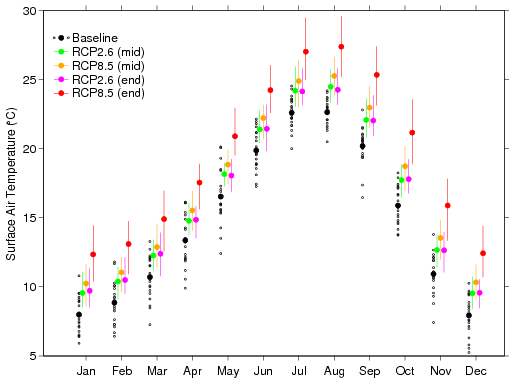 |
| Figure: Annual cycle of Los Angeles region surface air temperature (°C) for the baseline period (black), mid-21st-century under RCP2.6 (green), mid-21st-century under RCP8.5 (orange), end-of-21st-century under RCP2.6 (magenta), and end-of-21st-century under RCP8.5 (red). Black solid dots denote the 20-yr baseline climatology, and black open circles denote monthly mean for each year during baseline period (1981–2000). Other solid dots denote the ensemble-mean climatology for their respective scenario and time slice; bars denote the range across all the downscaled GCMs. |
Ph.D. research:
In his Ph.D. research, he examined tropical Pacific climate dynamics and ocean-atmosphere interactions with a focus on El Nino-Southern Oscillation (ENSO) and its decadal modulation using multiple observational, satellite and reanalysis data as well as atmospheric modeling with Community Atmospheric Model (CAM).
He also investigated the ENSO simulation bias in global climate models, such as Community Climate System Model version 3 (CCSM3) by designing and analyzing ocean-atmosphere coupled and decoupled sensitivity experiments and proposed a theory to explain the ENSO bias and its linkage to the Indian Ocean and monsoon variability.
Prior to his Ph.D. work, he focused on the roles of weather extremes, e.g., strong mountain-gap wind in regulating sea surface temperatures by designing and implementing Regional Ocean Modeling System (ROMS) experiments.